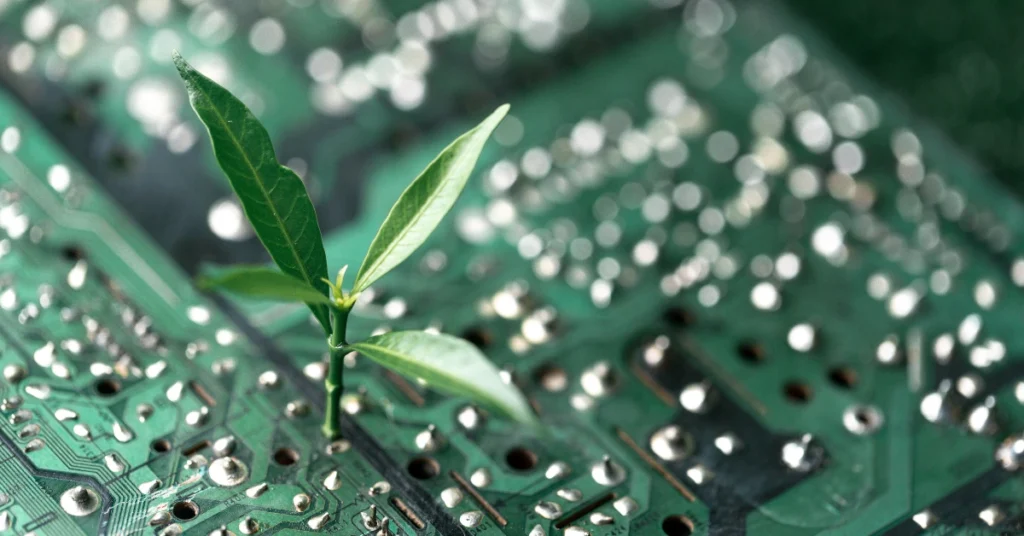With technology playing a central role in daily life, our tech habits have a considerable impact on the environment. Green computing—also known as sustainable computing—focuses on reducing the ecological footprint of technology by promoting energy-efficient practices, reducing electronic waste (e-waste), and choosing eco-friendly devices. By adopting green computing practices, we can contribute to a more sustainable digital future while lowering our energy usage and waste production.
This article explores practical ways to make your tech habits more sustainable, from choosing energy-efficient devices to reducing e-waste and optimizing daily tech usage.
What is Green Computing?
Understanding Green Computing
Green computing refers to environmentally responsible use of technology by minimizing resource consumption and reducing waste. This approach encompasses various aspects, including energy-efficient hardware, sustainable manufacturing, responsible disposal, and energy-conscious usage. The goal of green computing is to reduce the negative environmental impact of technology while promoting long-term sustainability in the digital world.
Green computing addresses the full lifecycle of technology—from manufacturing to disposal—encouraging sustainable practices at every stage.
The Environmental Impact of Technology
From energy consumption to e-waste, technology has a substantial environmental impact. Data centers, which power online services, consume vast amounts of electricity, often relying on non-renewable energy sources. Additionally, rapid advancements in technology contribute to shorter device lifespans, creating a growing amount of e-waste. By making eco-friendly choices, individuals and businesses can help mitigate these environmental effects.
Understanding the impact of our tech habits is the first step toward adopting green computing practices that contribute to a healthier planet.
Green Computing Tips for Sustainable Tech Habits
1. Choose Energy-Efficient Devices
Energy-efficient devices consume less power, reducing electricity usage and lowering overall environmental impact. Look for ENERGY STAR-certified products or devices with energy-saving features, which are designed to use minimal electricity without compromising performance.
Tip: Before purchasing new tech, research energy-efficient options, and consider devices that offer sleep modes or power-saving settings to minimize energy consumption.
To learn about products that can help you reduce energy consumption at home, explore this guide on Energy Efficiency Products from EnergySage. It provides insights on various solutions that can lower your energy bills and support a more sustainable lifestyle.

2. Opt for Refurbished or Certified Pre-Owned Devices
Buying refurbished or certified pre-owned devices is an effective way to reduce electronic waste. These products are restored to full functionality, extending the life cycle of technology and reducing the need for new manufacturing, which consumes energy and resources.
Tip: When looking for a new device, consider purchasing from reputable sources that offer certified pre-owned or refurbished options. This choice supports a circular economy and reduces demand for new resources.
3. Unplug Devices When Not in Use
Many electronic devices continue to draw power even when turned off. By unplugging devices when not in use, you can reduce energy waste and save on electricity costs. Using power strips with an on/off switch also makes it easier to disconnect multiple devices at once.
Tip: Unplug chargers, laptops, and appliances when they’re not in use, or use a smart power strip to automatically cut power to devices when they’re inactive.
Reducing E-Waste Through Responsible Disposal
Recycle Electronics Properly
Electronic waste contains valuable materials that can be recycled and reused. However, e-waste must be disposed of properly to avoid harmful chemicals leaching into the environment. Look for certified e-waste recycling programs in your area or participate in tech companies’ trade-in or recycling initiatives.
Tip: Research local e-waste recycling centers or participate in retailer programs that accept old devices, ensuring they’re disposed of responsibly.
For tips on reducing environmental impact when disposing of electronics, check out this guide on 8 Responsible Ways to Handle E-Waste from B-Comp Services. It offers practical advice for recycling and safely managing e-waste to protect the planet.
Donate or Repurpose Old Devices
If you have older devices that are still functional, consider donating or repurposing them. Many charities and organizations accept used electronics to support education, low-income families, or community programs. Repurposing old devices, such as using an old tablet as a digital photo frame, also reduces waste.
Tip: Look for local organizations that accept used electronics, or find creative ways to repurpose your old tech devices for practical use.

Avoid Frequent Upgrades
Constantly upgrading to the latest devices contributes to e-waste. By extending the life of your current devices and upgrading only when necessary, you reduce demand for new resources and limit waste. Regular maintenance, such as software updates and battery care, can keep devices running smoothly for years.
Tip: Before upgrading, consider whether your current device meets your needs. Simple upgrades, like adding memory or replacing a battery, can extend a device’s life and reduce environmental impact.
Energy-Saving Practices for Daily Tech Usage
Use Energy-Saving Settings
Most devices offer energy-saving settings that reduce power consumption. Adjusting settings like screen brightness, sleep mode timing, and power-saving mode can significantly reduce energy usage. Many computers and smartphones also allow you to monitor energy use and adjust settings for optimal efficiency.
Tip: Explore your device’s energy settings and enable features like sleep mode, auto-brightness, and power-saving modes to conserve energy.
Reduce Cloud Storage Usage
Cloud storage services require energy-intensive data centers to operate. By reducing unnecessary files and organizing your cloud storage, you minimize energy consumption. Delete unused files, limit duplicate content, and use offline storage when possible to reduce your digital footprint.
Tip: Regularly clean out your cloud storage, deleting files you no longer need, and consider local storage options for files that don’t require frequent access.
Embrace Digital Minimalism
Digital minimalism—using only the technology that truly adds value—can reduce energy usage and limit device wear. By minimizing apps, software, and online activity, you can cut down on resource consumption and reduce the need for frequent tech upgrades.
Tip: Evaluate which apps, services, and devices you actually need, and eliminate any that add unnecessary clutter or energy usage.
How Companies Are Supporting Green Computing
Eco-Friendly Manufacturing Practices
Tech companies are increasingly adopting eco-friendly manufacturing practices, such as using recycled materials, reducing water and energy consumption, and minimizing hazardous chemicals. Brands like Apple, Dell, and HP are setting sustainability goals to make their production processes greener.
Example: Apple has committed to using 100% recycled aluminum in certain products, reducing the environmental impact of manufacturing and supporting a circular economy.
Green Data Centers
Data centers are responsible for a large share of technology’s energy consumption. To address this, many companies are building green data centers powered by renewable energy sources like wind and solar. These facilities also use energy-efficient cooling systems to reduce electricity usage.
Example: Google and Microsoft have implemented renewable energy in their data centers, contributing to carbon-neutral and eco-friendly tech infrastructure.
To discover how sustainable practices are transforming the tech industry, explore IBM’s overview of Green DataCenters. This resource explains how energy-efficient data centers are helping reduce environmental impact while supporting modern digital needs.

Carbon Offset Programs and E-Waste Recycling
Many tech companies are investing in carbon offset programs and offering e-waste recycling initiatives. Through carbon offsets, companies support projects that reduce greenhouse gases, such as reforestation and renewable energy. Recycling programs also provide consumers with options for disposing of old devices responsibly.
Example: Dell’s recycling program accepts old devices from any brand, allowing users to responsibly dispose of e-waste and reduce their environmental impact.
Green computing is an important approach to reducing the environmental impact of our tech habits. By choosing energy-efficient devices, minimizing e-waste, and optimizing daily tech usage, we can contribute to a more sustainable future. From responsible disposal practices to embracing digital minimalism, small changes in our tech routines can make a significant difference.
With the right habits, green computing helps us enjoy the benefits of technology while preserving resources for future generations. By adopting sustainable tech practices, we can play an active role in reducing the ecological footprint of the digital world.
For insights into how technology is driving eco-friendly advancements, take a look at our article on How AI is ShapingSustainable Agriculture. This piece explores the transformative role of AI in promoting more sustainable and efficient farming practices.






















